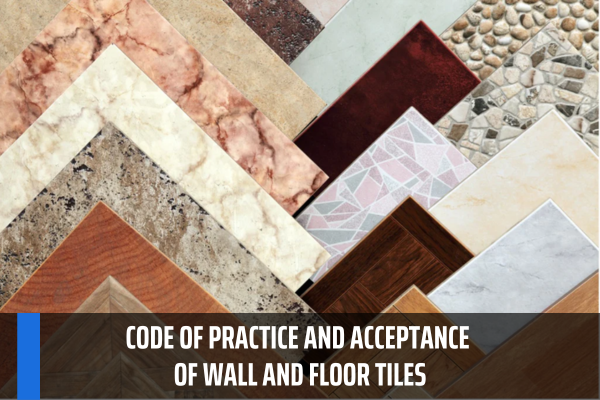What are the contents of National Standard TCVN 8264:2009 on code of practice and acceptance of wall and floor tiles in Vietnam?
What is the scope of application and reference documents of National Standard TCVN 8264:2009?
Pursuant to the provisions in Sections 1 and 2, National Standard TCVN 8264:2009 clearly states the scope of application and reference documents as follows:
Scope of application
This standard regulates the construction and acceptance of tiling work in civil and industrial construction projects for ceramic tile products, terrazzo tiles, mosaic tiles and natural stone tiles.
Reference documents
The following referenced documents are necessary for the application of this standard. For referenced documents stating the year of publication, the version mentioned applies. For referenced documents without publication year, the latest version applies, including amendments and supplements (if any).
TCVN 4085: 1985, Brick and stone structures - Rules for construction and acceptance.
TCVN 4314: 2003, Construction mortar - Technical requirements.
TCVN 4452: 1987, Assembled reinforced concrete structures - Rules for construction and acceptance.
TCVN 4453: 1995, Entire concrete and reinforced concrete structures - Rules for construction and acceptance.
TCVN 4732: 2007, Natural paving stone.
TCVN 7744: 2007, Terrazzo tiles.
TCVN 7745: 2007, Semi-dry pressed ceramic tiles - Technical requirements.
TCVN 7483: 2005, Flexible extruded ceramic tiles - Technical requirements.
TCVN 7899-1: 2008, Ceramic tiles - Mortar, grout and tile adhesive - Part 1: Terminology, definitions and technical requirements for mortar and tile adhesive.
TCVN 7899-3: 2008, Ceramic tiles - Mortar, grout and tile adhesive - Part 3: Terminology, definitions and technical requirements for mortar and grout.
TCXDVN 336: 2005, Tile mortar - Technical requirements and test methods.

What are the contents of National Standard TCVN 8264:2009 on code of practice and acceptance of wall and floor tiles in Vietnam? (Image from the Internet)
What are the contents of National Standard TCVN 8264:2009 on code of practice and acceptance of wall and floor tiles in Vietnam?
Pursuant to the provisions in Section 4 of National Standard TCVN 8264:2009, general regulations for code of practice and acceptance of wall and floor tiles are clearly stated as follows:
- The provisions in this code apply equally when constructing inside and outside the building.
- Construction direction when cladding external walls:
+ For new construction, the construction process is carried out from the top floor down.
+ For repair works, the construction process can be carried out from the lower floor up.
+ Depending on each specific project, the contractor can recommend appropriate construction solutions.
- Before proceeding with construction, it is necessary to complete relevant work to avoid any collisions that damage or affect the quality of the cladding surface. Plan work to ensure enough time for construction and time to avoid walking on newly paved areas.
- All water pipes, gas pipes, electrical cables, and electrical piping boxes are securely attached before construction is carried out. Before cladding the exterior of locations where technical pipes run through such as vent pipes, ventilation pipes, smoke vents, channels for refrigeration equipment and places where the temperature changes frequently, it is necessary to wrap them around them. The structure is covered with a layer of steel mesh with a diameter of 1 mm before plastering. The covered mesh section must extend beyond the technical lines by at least 20 cm.
- When the binding material begins to harden, it must not be mixed again but must be discarded.
- When cladding natural stone materials with large sizes and weight over 5 kg, metal hooks or a mounting system with screws and adjustment bolts should be used to firmly attach to the cladding surface. In case of cladding the exterior of the building using this method, there must be waterproofing measures for the exterior of the wall when cladding.
- When constructing, avoid cutting tiles as much as possible. If cutting is required, the cut pieces should be placed in hidden locations. If the tiling product has a pattern, it is necessary to select and arrange the panels next to each other to match the color, gloss, harmony of grain and according to the instructions of the design architect.
Vietnam: What are the regulations on installation of wall and floor tiles?
Pursuant to the provisions of Section 6 of National Standard TCVN 8264:2009, it clearly states the installation of wall and floor tiles as follows:
Prepare paving materials and mounting materials
- Tiles must be cleaned, free of dirt, grease, and substances that reduce adhesion between the base layer and the tile layer.
- For paving materials capable of absorbing water from the binding material, the paving material must be soaked in water and drained before paving.
- Mixing, use and storage of bonding materials must comply with the requirements of each type of material.
- Mounting materials can be cement-sand mortar, triple mortar, tile mortar, and glue.
Prepare the base layer
- Use tension wire, wire or surveying machine to check the elevation, flatness, and slope of the base layer.
- Attach standard elevation markers, each room has at least four markers at the four corners, large area markers are mounted according to a square grid, the distance between markers is not more than 3 m.
Paving tools
- Need to prepare all the necessary tools for paving work such as: masonry knife, paving trowel, trowel, 3m ruler, ruler, rubber hammer, tile cutter, tile grinder, chisel, broom , rag, needle or surveying machine.
- Tools need to be complete and suitable for construction requirements for each occupational operation. Tools that are damaged, too old, worn, or not accurate when constructing should not be used.
Proceed to pave
Paving with sand-cement mortar
- Spread the mortar evenly on the surface of the substrate large enough to lay 3 to 5 tiles. After all these tiles have been laid, return the mortar to the next layer.
- After the mortar layer has hardened, sprinkle a layer of cement powder on the layer of mortar you just spread or spread a layer of cement paste on the back of the brick.
- Place the bricks immediately in position, avoid pressing the brick corners.
- Use a rubber hammer to gently tap and align the surface so that it is flat, straight and straight along the tension wire.
- The sequence is as follows: stretch the rope and lay the bricks on the straight line connecting the landmarks attached to the base layer. Then lay the bricks within the standard elevation markers, the paving direction is perpendicular to the previously laid direction. The general paving direction for an entire house or building is from the inside outward.
- While paving, regularly use a 3 m ruler to check the flatness of the paving surface. The flatness of the paving surface is checked in the vertical, horizontal and diagonal directions. Regularly check the paving surface elevation based on reference elevation markers.
- When paving, pay attention to arranging the tiles according to the design pattern.
Paving with tile adhesive or mortar
- Tiling is done one by one and the bonding material must be spread evenly on the back of the brick.
- Use a rubber hammer to gently tap and align the surface so that it is flat, straight and straight along the tension wire.
- Paving sequence by slice with sand-cement mortar
Paving with semi-dry mortar
- This method is used for terrazzo tiles.
- Spread on the surface of the substrate a layer of cement paste 2 mm thick.
- Next, spread and compact the semi-dry mortar layer with a thickness about 10% to 15% greater than the design thickness. The amount of mortar spread evenly on the surface of the substrate is large enough to lay 3 to 5 tiles. After all these tiles have been laid, the mortar will be spread again.
- Use cement paste to spread on the back of the brick and immediately place it in position, avoiding pressing the corners of the brick.
- Align the bricks in a balanced, straight and straight line according to the tension wire. Then tap lightly to make the tile surface flat and firmly attached to the mortar.
- Clean the cement paste on the surface of the paving layer.
Insert circuit slice
- The work of inserting tile joints is only carried out when the tiles are bonded to the substrate. Before inserting paving slabs, the paving surface must be clean. After inserting the tile, immediately clean the tile to make it sharp and clean the tile surface to prevent the tile filler from sticking to the tile surface.
- Insertion time ranges from 12 h to 48 h.
Paving surface maintenance
- After filling the tile joints, do not impact strongly before the bonding material is sufficiently solid.
- With outdoor paving and mortar as the binding material, there must be measures to cover the sun and prevent rain and rain for 1 to 3 days after paving.
LawNet
